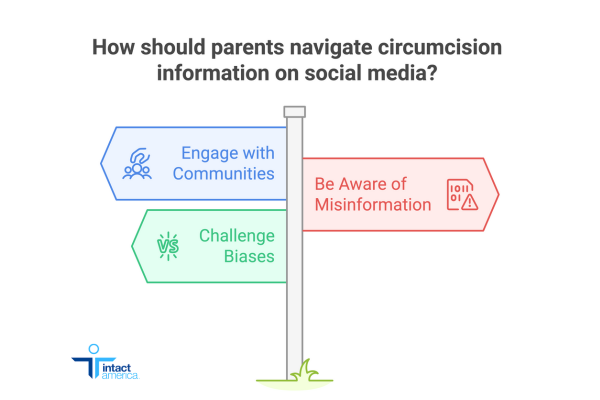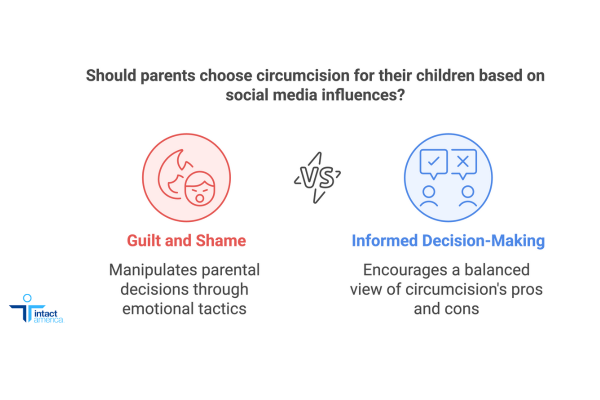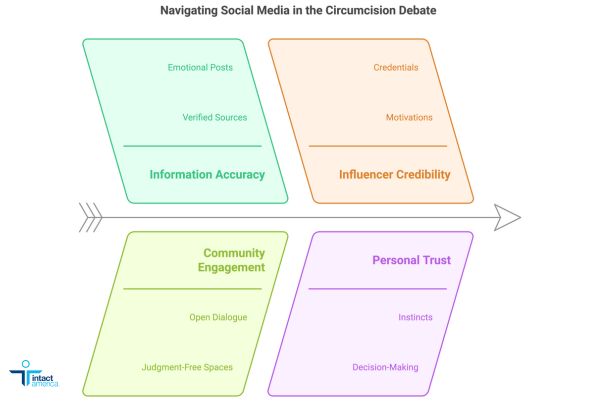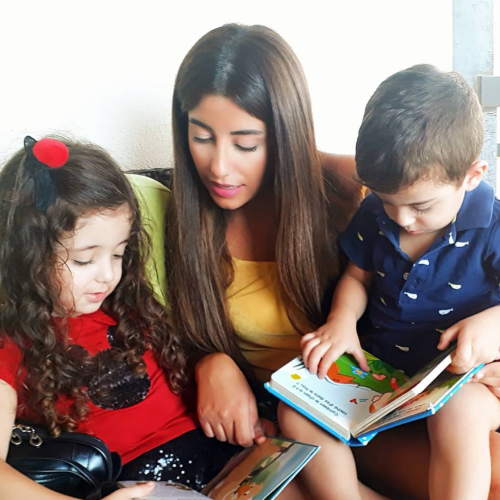
Social media has become the modern town square, shaping opinions on everything from politics to parenting. Among the endless scroll of viral dance challenges and meal-prep tutorials, a heavier topic has emerged: circumcision. Once a private decision confined to hospital rooms and family discussions, it has become a public debate, amplified by digital platforms.
With its power to inform and influence, social media offers parents an unprecedented range of perspectives—but also exposes them to misinformation, bias, and intense social pressure. The question is: Does social media help parents make better decisions, or does it manipulate them into following the loudest voices?
A Collision of Narratives
 In theory, social media’s access to information should empower parents. A few clicks can reveal medical studies, personal stories, and advice from experts. Platforms like Reddit, TikTok, Instagram, and Facebook teem with conversations about circumcision, offering parents a front-row seat to both sides of the debate. Communities like r/Intactivism passionately argue against circumcision, while other groups advocate for its cultural, religious, or perceived medical benefits.
In theory, social media’s access to information should empower parents. A few clicks can reveal medical studies, personal stories, and advice from experts. Platforms like Reddit, TikTok, Instagram, and Facebook teem with conversations about circumcision, offering parents a front-row seat to both sides of the debate. Communities like r/Intactivism passionately argue against circumcision, while other groups advocate for its cultural, religious, or perceived medical benefits.
However, the reality is more complex. Algorithms prioritize content based on engagement, not accuracy, amplifying emotionally charged posts over balanced discussions. A quick search for “circumcision pros and cons” can lead parents into an echo chamber, reinforcing their biases rather than challenging them.
Misinformation is rampant. Overblown claims about hygiene benefits or exaggerated horror stories about foreskin-related diseases circulate unchecked. This paradox—more access but less clarity—leaves many parents overwhelmed and unsure of what’s true.
The Rise of Influencers
In the age of momfluencers and TikTok doctors, influencers have become key players in parenting decisions. Some use their platforms to educate, sharing studies and personal experiences about the risks and ethics of circumcision. Others perpetuate myths, pushing outdated ideas about cleanliness or aesthetics.
One common scare tactic is the “locker room argument,” where influencers claim intact boys will face bullying. This narrative preys on parental fears, suggesting conformity is essential to a child’s happiness. However, research shows that confidence—not conformity—determines how children navigate social pressures.
On the other hand, anti-circumcision advocates have harnessed social media’s power to challenge cultural norms. Hashtags like #ForeskinIsNormal and #IntactGeneration have gained traction, encouraging parents to reconsider long-held assumptions. While these campaigns provide an important counterbalance, their emotionally charged nature can sometimes alienate undecided parents who feel attacked rather than informed.
Guilt and Shame: The Ultimate Weapons
 Few decisions carry as much weight as circumcision. Social media preys on this vulnerability, weaponizing guilt and shame. Posts with captions like, “Good parents don’t mutilate their children,” or, “Why risk your child’s health by leaving them intact?” create a no-win situation for parents.
Few decisions carry as much weight as circumcision. Social media preys on this vulnerability, weaponizing guilt and shame. Posts with captions like, “Good parents don’t mutilate their children,” or, “Why risk your child’s health by leaving them intact?” create a no-win situation for parents.
Graphic images, heart-wrenching testimonials, and glowing endorsements of “modern circumcision methods” dominate feeds, pulling at heartstrings but often lacking context. Pro-circumcision content frequently employs fear-mongering, warning parents about infections or diseases without presenting the full picture.
The result is a paralyzing cycle of doubt and anxiety, where parents feel unable to make confident decisions amid the digital noise.
Cultural Bias in the Algorithm
Social media platforms reflect societal norms, often reinforcing cultural biases. In the U.S., circumcision has historically been widespread, driven by a mix of tradition and outdated medical advice. This cultural backdrop influences the algorithms that shape online discussions, ensuring that pro-circumcision narratives dominate.
Parents browsing parenting blogs or forums are more likely to encounter content normalizing circumcision as a default choice. These posts rarely explore the global context, where circumcision is far less common. For example, most European countries maintain significantly lower circumcision rates without the dire health consequences often cited in American debates.
This bias silences alternative perspectives, making it harder for parents to consider leaving their child intact.
The Power of Personal Stories
One of social media’s greatest strengths is storytelling. Personal accounts from circumcised men or parents who regret their decision add emotional depth to the debate. A viral post about a man’s struggles with sensitivity loss or a video of a newborn enduring the procedure can make the issue feel deeply personal.
Stories like these break through cultural norms, inviting empathy and introspection. However, the most sensational accounts often overshadow the more nuanced middle ground where many parents reside. While these stories can provoke thought, they rarely provide the balanced perspective parents need.
Using Social Media for Good

Social media has the potential to be a force for good in the circumcision debate—if used thoughtfully. Here’s how parents can navigate the noise:
- Fact-Check Information: Prioritize verified sources like medical journals or statements from pediatric associations. Be wary of emotionally charged posts without credible evidence.
- Seek Balanced Communities: Join forums or groups that encourage open dialogue rather than pushing an agenda. A neutral space can help parents weigh their options without fear of judgment.
- Be Critical of Influencers: Question the credentials and motivations of influencers. Are they sharing facts, or are they profiting from clicks and engagement?
- Trust Yourself: Social media is a tool, not a decision-maker. Ultimately, parents must sift through the noise and trust their instincts.
A Future Beyond the Scroll
Social media is neither hero nor villain in the circumcision debate—it’s a tool that reflects the priorities and biases of its users. By fostering balanced conversations and promoting accurate information, platforms could help parents make more informed choices.
For parents, the key lies in reclaiming autonomy. While social media can provide perspectives and resources, the ultimate decision rests with those holding their newborn in their arms. By approaching the topic with curiosity and compassion, parents can cut through the noise and make choices that align with their values.
The debate over circumcision isn’t going anywhere, but with the right tools and mindset, it’s possible to navigate the digital minefield without losing sight of what matters most: the well-being of the child.
People Also Ask These Questions About Circumcision and Social Media
Q: What are the most common debates about circumcision on social media?
- A: Social media often features discussions about medical benefits, cultural practices, ethical considerations, and personal experiences related to circumcision.
Q: Are there social media communities supporting or opposing circumcision?
- A: Yes, there are online groups and forums advocating for both sides of the debate, offering support, education, and discussions.
Q: How does social media influence parental decisions on circumcision?
- A: Many parents turn to social media for stories and advice, but expert consultation is crucial for informed decisions.
Q: Can circumcision-related topics go viral on social media?
- A: Yes, viral posts often arise from personal stories, controversial opinions, or new research on the subject.






No Comments